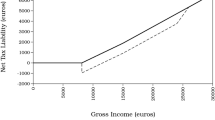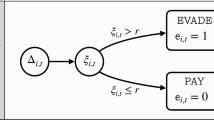Abstract
The U.S. tax gap is estimated to exceed $450 billion, most of which arises from non-compliance on the part of individual taxpayers (GAO 2012; IRS 2006). Much is hidden in innovative tax shelters combining multiple business structures such as partnerships, trusts, and S-corporations into complex transaction networks designed to reduce and obscure the true tax liabilities of their individual shareholders. One known gambit employed by these shelters is to offset real gains in one part of a portfolio by creating artificial capital losses elsewhere through the mechanism of “inflated basis” (TaxAnalysts 2005), a process made easier by the relatively flexible set of rules surrounding “pass-through” entities such as partnerships (IRS 2009). The ability to anticipate the likely forms of emerging evasion schemes would help auditors develop more efficient methods of reducing the tax gap. To this end, we have developed a prototype evolutionary algorithm designed to generate potential schemes of the inflated basis type described above. The algorithm takes as inputs a collection of asset types and tax entities, together with a rule-set governing asset exchanges between these entities. The schemes produced by the algorithm consist of sequences of transactions within an ownership network of tax entities. Schemes are ranked according to a “fitness function” (Goldberg in Genetic algorithms in search, optimization, and machine learning. Addison-Wesley, Boston, 1989); the very best schemes are those that afford the highest reduction in tax liability while incurring the lowest expected penalty.






Similar content being viewed by others
Notes
By “scheme” we shall mean a sequence of transactions arranged for the purposes of illegal tax evasion. It is worth noting, however, that in some instances the distinction between tax avoidance (which is legal) and tax evasion is not always clear.
References
Allingham MG, Sandmo A (1972) Income tax evasion: a theoretical analysis. J Public Econ 1:323–338
Andrei AL, Comer K, Koehler M (2013) An agent-based model of network effects on tax compliance and evasion. J Econ Psychol 40:119–133
Bloomquist KM (2006) A comparison of agent-based models of income tax evasion. Social Sci Comput Rev 24:411–425
Brabazon A, O’Neill M (2010) Biologically inspired algorithms for financial modeling. Springer, Heidelberg
The CPA Journal (2005) http://www.nysscpa.org/cpajournal/2005/205/essentials/p50.htm. Accessed 28 November 2013
Davis JS, Hecht G, Perkins JD (2003) Social behaviors, enforcement, and tax compliance dynamics. Account Rev 78:39–69
GAO-10-968 (2010) http://www.gao.gov/new.items/d10968. Accessed 28 November 2013
GAO-12-651T (2012) http://www.gao.gov/assets/600/590215. Accessed 28 November 2013
GAO-14-453 (2014) http://www.gao.gov/assets/670/663185. Accessed 26 June 2014
Goldberg DE (1989) Genetic algorithms in search, optimization, and machine learning. Addison-Wesley, Boston
Hamersley M (2004) Interview comments on PBS Frontline documentary “Tax Me if You Can” http://www.pbs.org/wgbh/pages/frontline/shows/tax/schemes/kpmg.html. Accessed 19 June 2014
Hokamp S, Pickhardt M (2010) Income tax evasion in a society of heterogeneous agents—evidence from an agent-based model. Int Econ J 24:541–553
IRS (2006) http://www.irs.gov/uac/IRS-The-Tax-Gap. Accessed 28 November 2013
IRS (2009) http://www.irs.gov/pub/irs-pdf/p3744. Accessed 28 November 2013
IRS (2011) http://www.irs.gov/Businesses/Guidance-for-Examiners-and-Managers-on-the-Codified-Economic-Substance-Doctrine-and-Related-Penalties. Accessed 28 November 2013
IRS (2013) http://www.irs.gov/publications/p556/index.html. Accessed 28 November 2013
Robertson JF, Quinn T, Carr R (2010) Codification of the economic substance doctrine. J Bus Adm Online 9(2):1–7
TaxAnalysts (2005) http://www.taxanalysts.com/www/freefiles.nsf/Files/106TN0453/file/106TN0453. Accessed 28 November 2013
Wright D (2013) Financial Alchemy: how tax shelter promoters use financial products to bedevil the IRS (and How the IRS Helps Them), Valparaiso University Legal Studies Research Paper No. 13–3
Acknowledgments
The authors would like to thank Alan Plumley, Kim Bloomquist, Amalia Miller and the journal reviewers for their helpful comments and feedback. This work was supported in whole by The MITRE Corporation Innovation Program. This assistance is greatly appreciated.
Author information
Authors and Affiliations
Corresponding author
Rights and permissions
About this article
Cite this article
Warner, G., Wijesinghe, S., Marques, U. et al. Modeling tax evasion with genetic algorithms. Econ Gov 16, 165–178 (2015). https://doi.org/10.1007/s10101-014-0152-7
Received:
Accepted:
Published:
Issue Date:
DOI: https://doi.org/10.1007/s10101-014-0152-7




